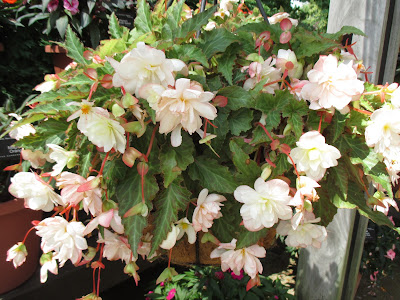Some winter weather arrived today in the form of snow/sleet/freezing rain along with some wind. I'm glad it missed the Holiday Light Show (HLS) last night which again saw strong crowds on a nice evening. We have two more nights of the HLS on January 2nd and 3rd and are pleased that the event has gone so well despite having to cancel two nights due to weather (rain!). Big John and Larry H. were here this morning. Larry went out to work on some HLS elements and Bill O. was in as well to empty the garbage cans along the HLS route. Dick H. and Bill also worked on one of our trucks and Maury F. was in for some errands. We also saw Carrie and Janice. It was a quiet day at the Horticulture Center which was just perfect for me to switch gears to 2016.
It's difficult to keep up with all the varieties of coneflowers (Echinacea sp.) and hybrids that have been introduced over the last 15 years or so. It has been nice to see such a great range of colors become available for the consumer but who can really keep up? They all look beautiful in the gardening catalogs but the "proof is in the pudding" as they say. I commit to an Echinacea variety once I've seen its performance in the ground which should reveal not only true color but stature in terms of "stem strength". I rarely order a variety based on a photo of the flower. I feel many of the new varieties, while beautiful, lack the stem strength to support the flowers and become a floppy mess that requires staking. My concern about flower color also revolves around how flowers "age" on the plant. Do they maintain a nice degree of the original shade (white, orange, yellow, purple, red, etc.) or do the older flowers look unsightly and detract from the overall appearance of the plant (despite vivid new blooms)? I have been VERY smitten with the Sombrero series which has the best features of strong stems and excellent coloration throughout the bloom period. Above and directly below is Echinacea Sombrero Flamenco Orange ('Balsomenco') which is my current favorite of the series of eight selections. Most of these are in the 24"-30" range and are great for wildlife as well. Purple coneflowers (Echinacea purpurea) and their hybrids that include this parentage are not long-lived perennials. It's important to note this fact and understand that getting 2-3 years out these plants is typical and should be considered when they are purchased. I feel they are certainly worth the "real estate", particularly this Sombrero Series.
Echinacea Sombrero Lemon Yellow ('Balsomemy')
Echinacea Sombrero Adobe Orange ('Balsomador')
Echinacea Sombrero Sandy Yellow ('Balsomselo') - above and two below
Echinacea Sombrero Baja Burgundy ('Balsombabur')
Echinacea Sombrero Blanco ('Balsomblanc')
Echinacea Sombrero Salsa Red ('Balsomsed')
Echinacea Sombrero Hot Coral ('Balsomcor') both above and below































































